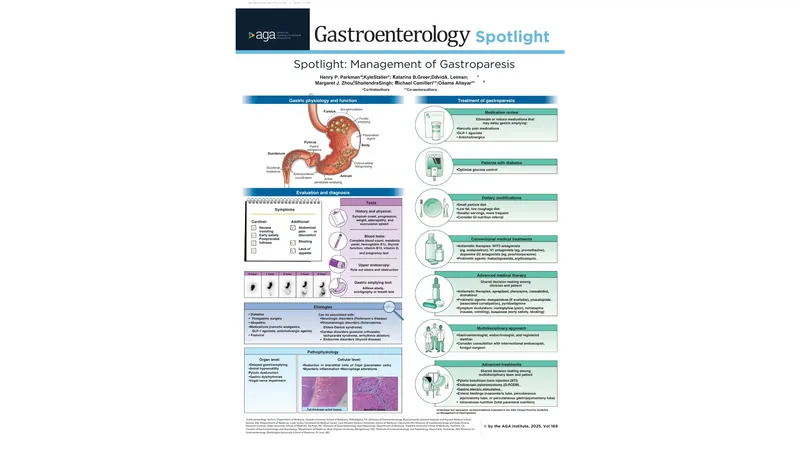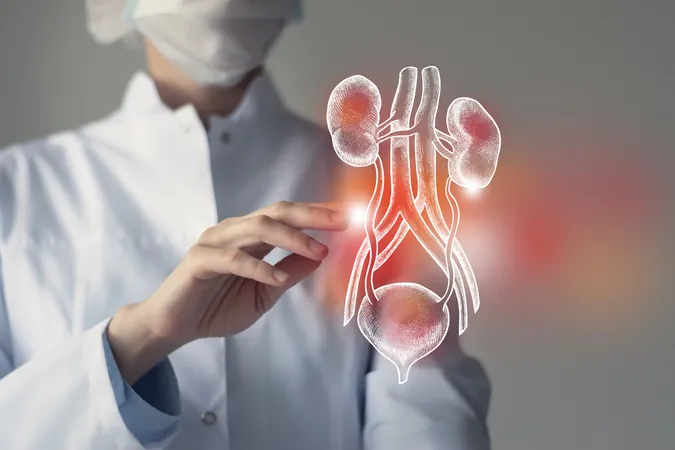
New Guidelines Illuminate the Path for Personalized Care in Gastroparesis Patients
2025-09-19
Author: Mei
The Complexities of Gastroparesis
The American Gastroenterological Association (AGA) has unveiled groundbreaking clinical guidelines for managing gastroparesis, a daunting condition that affects thousands and significantly disrupts daily life. Published in the esteemed journal 'Gastroenterology', these guidelines introduce 12 recommendations designed to personalize patient care.
No One-Size-Fits-All Solution
Rather than advocating a single treatment route, the guidelines stress the intricate nature of gastroparesis, calling for specialized discussions between healthcare providers and patients. The principles outlined in the guidelines aim to construct tailored care plans, understanding that what works for one individual may not suit another.
"Every patient's situation is unique," said Dr. Osama Altayar, co-chair of the guideline panel. "This framework empowers physicians to collaborate with their patients in decision-making rather than dictating treatment."
A Call for Introduction of New Therapies
Dr. Kyle Staller, the panel chair, highlighted the pressing need for innovative therapies, pointing to the current gaps in treatment options. "Public commentary played a crucial role in shaping these guidelines, ensuring we remain sensitive to the needs of patients and their physicians," he remarked.
Measuring Gastric Emptying: A Key Recommendation
In a significant recommendation, the AGA advocates for a comprehensive four-hour gastric emptying study to assess patients' conditions accurately, thus discarding shorter studies that may lead to misdiagnosis. Furthermore, medications like metoclopramide and erythromycin are recommended for initial therapy, with patient preferences and thorough decision-making guiding further treatments.
Defining the Disease: A Huge Challenge
One of the many challenges in managing gastroparesis lies in its vague definition. Dr. Staller emphasized a crucial goal of these guidelines: to create a clearer understanding of the condition, linking symptoms directly with evidence of delayed gastric emptying.
Crucial Recommendations to Note
Here are key recommendations outlined by the AGA: - Reject two-hour studies for gastric emptying in favor of four-hour assessments. - Utilize metoclopramide and erythromycin as initial pharmacologic therapies. - Advise against using domperidone, prucalopride, aprepitant, nortriptyline, and buspirone as first-line treatments.
The AGA also recommends caution in using cannabidiol (CBD) and against routine use of botulinum toxin injections, gastric peroral endoscopic pyloromyotomy (G-POEM), and gastric electrical stimulation for patients unresponsive to initial therapies.
Despite these recommendations, Dr. Staller noted that they do not impose hard limits. Each patient's unique circumstances must dictate their treatment pathway.
The Underlying Mechanism of Gastroparesis
Gastroparesis occurs when the stomach is unable to move its contents into the small intestine effectively, resulting in a host of uncomfortable symptoms such as nausea and bloating. This condition can stem from dysfunction in the stomach muscles, nerves, or pacemaker-like cells, all of which impede normal digestion.
A Hopeful Future for Patients
With these new guidelines, there's a renewed hope for those suffering from gastroparesis. By pushing for enhanced research, clearer definitions, and innovative treatments, the AGA aims to bridge existing gaps in care, helping to restore quality of life for countless patients.




 Brasil (PT)
Brasil (PT)
 Canada (EN)
Canada (EN)
 Chile (ES)
Chile (ES)
 Česko (CS)
Česko (CS)
 대한민국 (KO)
대한민국 (KO)
 España (ES)
España (ES)
 France (FR)
France (FR)
 Hong Kong (EN)
Hong Kong (EN)
 Italia (IT)
Italia (IT)
 日本 (JA)
日本 (JA)
 Magyarország (HU)
Magyarország (HU)
 Norge (NO)
Norge (NO)
 Polska (PL)
Polska (PL)
 Schweiz (DE)
Schweiz (DE)
 Singapore (EN)
Singapore (EN)
 Sverige (SV)
Sverige (SV)
 Suomi (FI)
Suomi (FI)
 Türkiye (TR)
Türkiye (TR)
 الإمارات العربية المتحدة (AR)
الإمارات العربية المتحدة (AR)